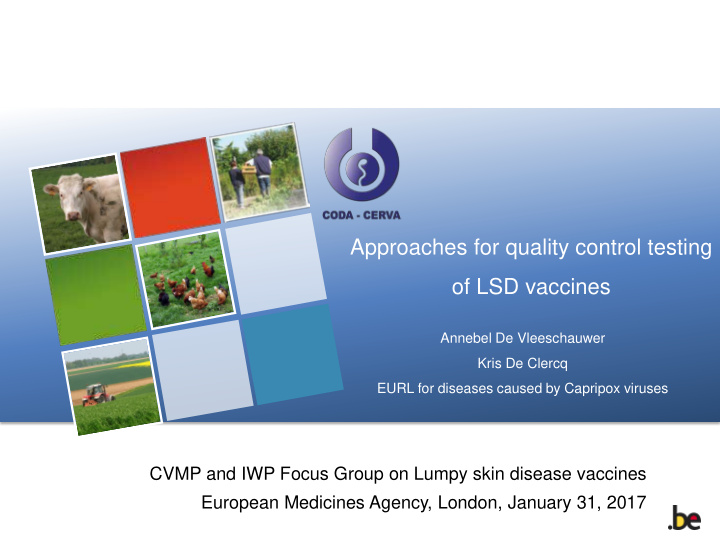



Approaches for quality control testing of LSD vaccines Annebel De Vleeschauwer Kris De Clercq EURL for diseases caused by Capripox viruses CVMP and IWP Focus Group on Lumpy skin disease vaccines European Medicines Agency, London, January 31, 2017
LSD: Vaccination in Europe Directive 92/ 119/ EEC – art 19 : However, by way of derogation the decision to introduce em ergency vaccination may be taken by the Mem ber State concerned following notification of the Commission, provided that the fundamental interests of the Community are not affected. DIRECTIVE 2001/ 82/ EC – art 8: In the event of serious disease epidemic, Mem ber States may provisionally allow the use of immunological veterinary medicinal products w ithout an authorization for placing on the market, in the absence of a suitable medicinal product and after informing the Commission of the detailed conditions of use. Decision to use LSD vaccine: Member State – CVO
LSD: Vaccination in Europe Currently -Infected countries have been able to limit the spread or eradicate LSD with vaccination -Only live attenuated LSD vaccines are available -Live attenuated vaccines provide good protection in case a homologous vaccine is used in combination with sufficient vaccination coverage (> 80% needed) and a (re)vaccination policy of young animals and imported animals. -None of the vaccines used in Europe has a marketing authorisation within the European Union or other European countries -None of these vaccines is produced under GMP conditions -None of these vaccines is produced with a QC system as described in the European Pharmacopoeia
LSD Vaccine QC needed? LSD Vaccine: How much quality information or guarantees do you have now? -> Trust on Vaccine Manufacturer Information: Dossier: License / Registration Marketing Authorisation Quality Control LSD Vaccine: Registration Dossier available outside Europe? Tender for vaccine Purchase (EC/ Country): Quality criteria - Check criteria fulfilled? --> Needed? Field information on secondary effects after vaccine campaigns: - ‘Neethling disease’: < 1% - 10% - Milkdrop 6-9 dpv correlated with fever - Detection and isolation of Bluetongue virus from commercial vaccine batches (Bumbarov et al., 2016)
I ndependent LSD Vaccine QC Master Seed (MS) MS Registration Working Seed (WS) WS B Customer Batches (B)
1 . Master and W orking Seed Lot 1 .1 . Description of the production -Identity of the vaccine strain Confusing Kenyavac from JOVAC: Kenyan SGPV O-240 and 180 strains despite the name the strain is LSDV (Tuppurainen et al., 2014; Vandenbussche et al., 2016) -Substrates for seed culture preparation and for production - Sera, media, primary cells, cell cultures - Freedom from extraneous agents
1 . Master and W orking Seed Lot 1 .2 . Freedom from extraneous agents -Evidence of absence of bacterial, fungal or mycoplasmal contaminants -Evidence of absence of viral contaminants e.g. BTV, EHDV, BVD, BDV, SPPX, GTPX, Lentiviruses (Maedi-visna virus, Bovine leucosis virus)
1 . Master and W orking Seed Lot 1 .3 . Evaluation of safety -Laboratory studies using MS or WS of maximum titre - Administration of one dose: ≥ eight animals per group -One administration of an overdose: 10 doses, 8 young animals -Reproductive Performance: use in pregnant animals -Dissemination of vaccine strain in vaccinated animals -Increase in virulence – Reversion to virulence – Spread of the vaccine strain -Residues -Abnormal toxicity -Laboratory rodents -Field study
1 . Master and W orking Seed Lot 1 .4 . Evaluation of efficacy -Laboratory studies using WS of minimum titre expected at the end of the period of validity -Efficacy tests are carried out in the target species to show at least efficacy in protection against LSD upon viral challenge: ≥ 12 animals -Additional evidence must support all the claims being made, e.g. -onset and duration of immunity -onset and duration of protection -influence of passively acquired immunity
1 . Master and W orking Seed Lot 1 .5 . Stability -Period of validity (shelf-life): periodical re- titration 1 .6 . Pharm acovigilance -Continuous monitoring of LSD vaccines used in the field
2 . Batch controls 2 .1 . Description of the production -Identity of the vaccine strain -Substrates for batch preparation 2 .2 . Freedom from extraneous agents -Evidence of absence of bacterial, fungal or mycoplasmal contaminants -Evidence of absence of viral contaminants
2 . Batch controls 2 .3 . Safety -For each batch at least one -‘Administration of an overdose’ -Abnormal toxicity in laboratory rodents 2 .4 . Efficacy -Potency test -Ascertain that virus titre per vaccine dose of the vaccine batch under control is higher than the minimum protective dose (virus titration)
2 . Batch controls 2 .5 . Stability -Period of validity (shelf-life): periodical re- titration 2 .6 . Pharm acovigilance -Continuous monitoring of LSD vaccines used in the field
References -European Pharmacopeia 04/ 2013: 0062 Vaccines for Veterinary Use -European Pharmacopeia 04/ 2013: 50206 Evaluation of safety of veterinary vaccines and immunosera -European Pharmacopeia 04/ 2008: 50207 Evaluation of efficacy of veterinary vaccines and immunosera -European Pharmacopeia 01/ 2008: 50107 Viral safety -European Pharmacopeia 01/ 2008: 20609 Abnormal toxicity -European Pharmacopeia 04/ 2011: 20601 Sterility -European Pharmacopeia 01/ 2016: 50204 Cell cultures for the production of veterinary vaccines -European Pharmacopeia 07/ 2009: 50205 Substances of animal origin for the production of veterinary vaccines -OIE Chapter 1.1.8 Principles of veterinary vaccine production. Manual of Diagnostic Tests and Vaccines for Terrestrial Animals 2016. -OIE Chapter 1.1.9 Tests of biological materials for sterility and freedom from contamination. Manual of Diagnostic Tests and Vaccines for Terrestrial Animals 2016. -OIE Chapter 2.4.13 Lumpy Skin disease (Version adopted in May 2016).Manual of Diagnostic Tests and Vaccines for Terrestrial Animals 2016.
Recommend
More recommend